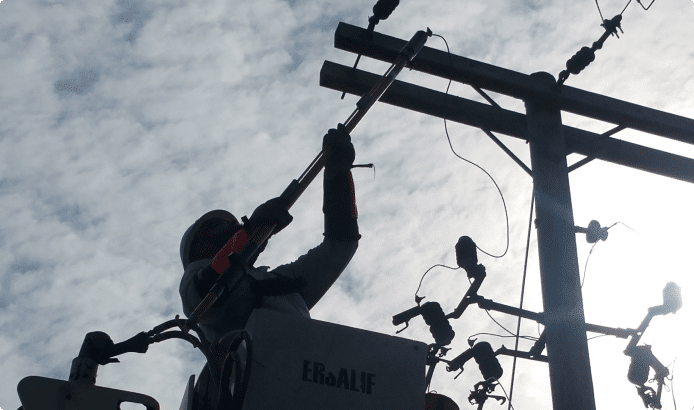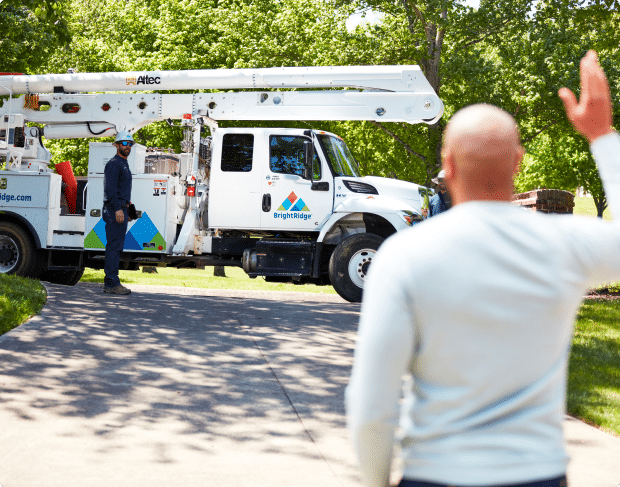Electric Outage Map
BrightRidge crews work 365 days a year to ensure reliable electric service for all customers. When large power outages occur, crews first restore power to the greatest number of metered customers at one time.
Report electric outages via SmartHub or by calling (423) 952-5000
Learn More About Electric Outages

Reasons for Outages
- Severe weather such as wind, thunderstorms, snowstorms, tornadoes, ice storms, etc.
- Animals, such as birds, snakes, or squirrels interfering with electrical equipment. Birds and squirrels are typically the number one cause of power outages throughout the BrightRidge service area.
- Auto accidents, which may strike and break utility poles
Overloaded lines - Equipment failures, such as, transformer fuses blowing, breakers malfunctioning, etc.
- Human error
What to Do
Have an emergency kit readily available in the event of a power outage.
Your emergency kit should include:
- Battery back-up for medical equipment
- Medications: enough for multiple days.
- First-Aid kit.
- Flashlights and extra batteries.
- Water: one gallon per person, per day.
- Non-perishable food: items that may be easily prepared.
- Battery-powered radio and extra batteries.
- Cell phone with extra mobile chargers.
- Sanitation and personal hygiene items.
- Extra blankets.
- One or more coolers.
Look to see if the neighbors’ lights are off.
If the neighbors’ lights are not off, the problem may be confined to your home.
Check fuses and breakers.
If there is a problem with the fuses or breakers, this may indicate the problem is confined to your home.
Turn off all electrical appliances that were on; especially heat pumps, air-conditioners, or electric heating.
This precautionary measure will aid in preventing the system from overloading once power is restored.
Monitor our BrightRidge website and social media updates on Facebook.
Also, turn on your battery-operated portable radio and listen for messages from BrightRidge via news media.
Have a backup plan.
If extreme conditions exist and power outages are widespread, consider making alternate arrangements until power is restored.
It is important to check on older friends, neighbors, and relatives during emergency situations.
You may even consider assisting them in making alternate arrangements if the power outage is expected to last for an extended period of time.
CAUTION: CARBON MONOXIDE KILLS.
Never use a generator, grill, camp stove or other gasoline, propane, kerosene, or natural gas burning device inside. Install carbon monoxide alarms inside your home on every level. Make sure batteries are changed regularly, and that the device(s) is in good working order. Click HERE for more tips on electrical/generator safety.
Keep refrigerator and freezer doors closed.
USDA Food Safety Tips
Steps for Restoring
BrightRidge crews work 365 days a year to ensure reliable electric service for all customers. When large power outages occur, crews first restore power to the greatest number of metered customers at one time. Next, crews restore service to individual, isolated cases. Generally, these steps are followed to restore power (electric service):
High-voltage transmission lines supply electricity to substations from TVA power plants where the electricity is produced. If the transmission lines are damaged, it is impossible for electricity to be supplied to anyone.
Substations receive electricity from transmission lines. Large transformers located at substations reduce electric voltage from 69,000 volts to approximately 13,000 volts. Substations must be repaired before electricity is supplied to distribution lines.
Distribution lines are the third link in the system to be repaired. Distribution lines may also be referred to as 3-phase lines and operate at 13,000 volts. These lines typically provide electricity to commercial and industrial customers, as well as supply electricity to single-phase lines.
Single-phase lines or tap lines operate at 7,200 volts, supplying electricity to residential areas. During extreme power interruptions, it may take several days to completely restore electricity to all tap lines as these are widespread and make up a large portion of our electric system.
The final step in the restoration process is to restore electricity to individual homes and small services. During the final step, electricity is generally supplied at a voltage of 120/240. Repairs to individual service lines and transformers can be very time-consuming as these individual services must be repaired one job at a time.